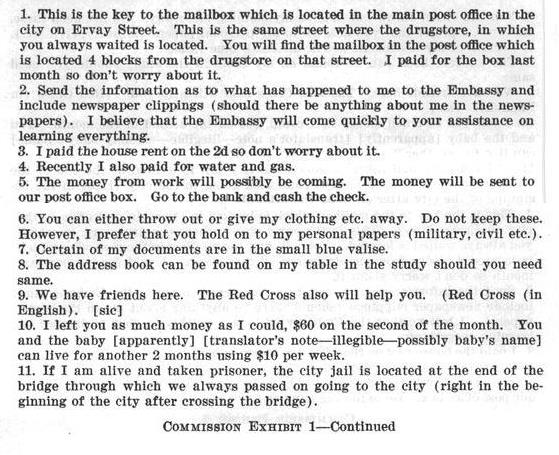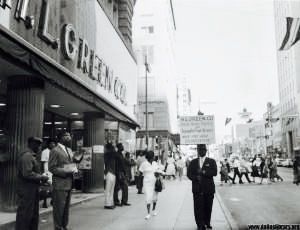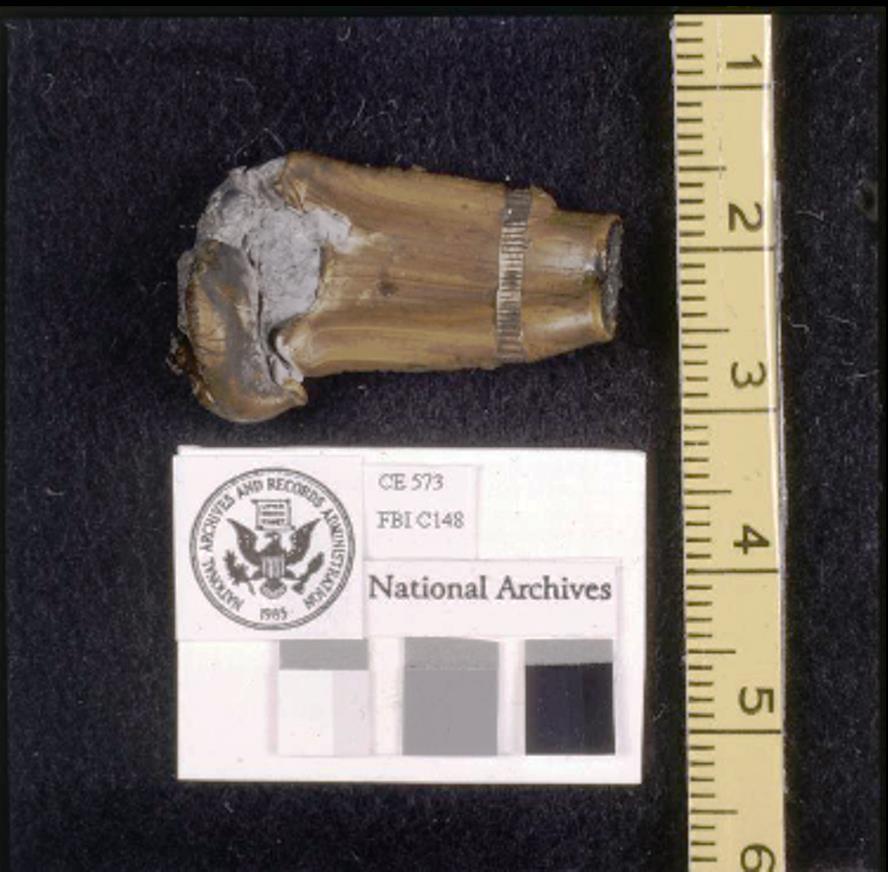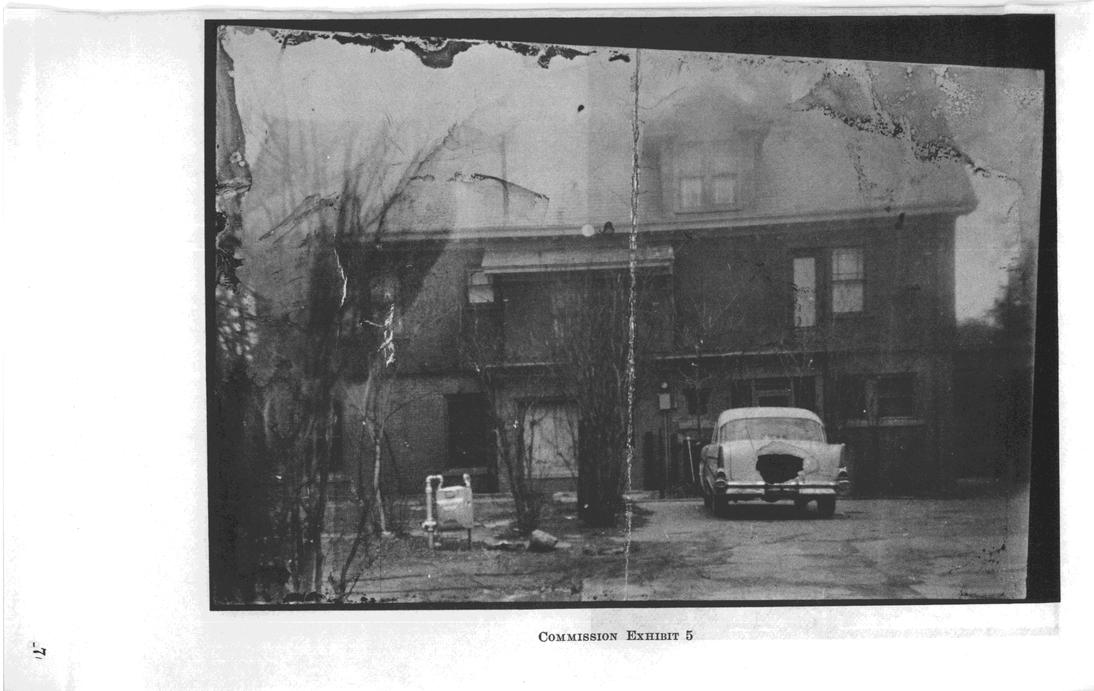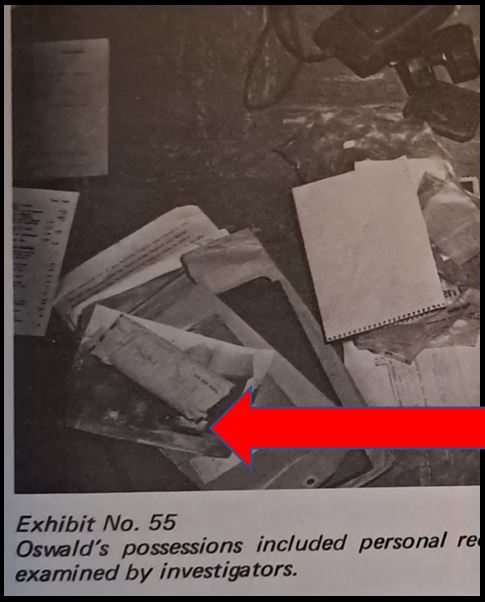Many of those who believe that Lee Harvey Oswald assassinated President John F Kennedy, and then killed Dallas Police Officer JD Tippit on 22nd November 1963, also advocate the view that Oswald attempted to shoot and kill General Edwin Walker on 10th April 1963. In fact, it is often presented as a historical fact, and that Oswald used the same Mannlicher Carcano rifle seven months later to murder JFK.
Oswald’s guilt in the Walker case was largely predicated on the testimony of his wife, photos of Walker’s house found amongst his belongings, an incriminating note attributed to Oswald that predicted an imminent event and, possibly, his own arrest or death arising from it.
As we approach the 60th anniversary of the Walker shooting incident, this article seeks to summarize some of the key evidence and arguments that cast doubt on Oswald being the mystery shooter who tried to take the General’s life. As we shall find out, it was not a fait accompli by any stretch of the imagination. First though, let’s go back to the night in question and briefly recap the generally known facts.
It was around 9pm on 10th April 1963. It had been a warm, sweltering Texas day and General Walker was sitting at his desk in the northwest ground floor room of his mansion in the Turtle Creek neighbourhood of Dallas completing his tax returns. This large house on Turtle Creek Boulevard also acted as an HQ for Walker’s political operations. He had, in fact, only just returned a few days earlier from a six-week speaking tour of the US with political sympathizer and evangelical preacher, Billy James Hargis. They controversially called their tour Operation Midnight Ride.
Suddenly, Walker heard what he initially thought was perhaps a firecracker. He then saw a hole in the wall next to where he had been sitting and realized that someone had just taken a shot at him. The bullet had deflected off the wooden window frame. This changed its trajectory and probably saved Walker’s life. When he knew it had been a shot, Walker told police that he ran upstairs to get his pistol. He heard a car leave but saw no shooter. Walker was lucky. The only injuries he sustained were minor cuts to his lower right arm, possibly caused by fragments of the bullet. Walker reported the incident to the police around 9:10pm. When they arrived at the scene, a mangled bullet was soon found in the next room on stacks of paper.
During the weeks and months that followed, the police were never able to positively identify who had taken the shot. A Scotsman by the name of William Duff, who was a former volunteer worker of Walker’s but left the house a month earlier, was arrested on 18th April 1963 and considered to be a suspect but this came to nothing (for more on William Duff, click here to see my presentation on him at the Dealey Plaza UK 2022 conference).
The attempted murder was unsolved until shortly after the assassination of JFK when the finger of suspicion was pointed directly at Lee Harvey Oswald. This started in late November/early December 1963. Of course, by then Oswald was conveniently dead and could not defend himself.
How did Oswald first become a suspect in the Walker shooting incident?
It was a right-wing German newspaper called the Deutsche National-Zeitung und Soldaten-Zeitung that first highlighted Oswald’s possible involvement in the Walker shooting incident when they published an article on 29th November 1963. This was based on interviews General Walker had given to the newspaper in the days following JFK’s assassination. It was likely Walker who planted the seed with them about Oswald being the person who took the shot at him.
We then have Ruth Paine visiting the Irving Police Department on 2nd December 1963 to hand over some of Marina Oswald’s belongings. Included was a Russian book called “Book of Useful Advice.” When the book was inspected by the Secret Service later that day, they found a two-page note inside written in Russian. This note was allegedly written by Oswald with instructions for his wife on what to do if he was killed or taken prisoner. Marina told law enforcement officials the day after the note was found that it was written by her husband, and she had first seen it on the night of the Walker shooting. She said that Lee had arrived home late that night and admitted to taking the shot and burying the rifle, which he would retrieve later.
From then on, it was a slam dunk! Oswald had shot at Walker, displaying a propensity for political assassination that ultimately led to JFK’s death. That has been the popular narrative ever since.
Did the note found in the book have another meaning?
The conventional wisdom has been that Oswald did indeed write the note in advance of the Walker incident, as he was aware that he could have been arrested or killed at the scene, or shortly afterwards. This is the Warren Commission exhibit and English translation of the note originally written in Russian (see original note here).
It is clear that whoever wrote the note was planning a dangerous activity. But the note did not mention the specific event. There is no mention of General Walker, and the note is not signed or dated. If Walker had been killed, and Oswald arrested (or worse), it is fanciful to suggest that there would not have been anything about the shooter or the incident in the newspapers. Walker was a high-profile political figure at the time, and this would have been a major national news story.
The reference to the Embassy probably means the Soviet Embassy. But would they have been quick to come to Marina’s assistance as the note suggests if Oswald had killed General Walker? Isn’t it more likely that they would not have wanted to associate themselves with such a violent and political act on American soil? However, maybe the note referred to a different event.
It is also interesting that the FBI examined the note in early December 1963 and “seven latent fingerprints were developed thereon. Latent prints are not identical with fingerprints of Lee Harvey Oswald or Marina Nikolaevna Oswald.” This is an odd finding given that Oswald was the alleged author of the note and Marina had also probably handled it (click here to see the latent print memorandum dated 5th December 1963).
Sylvia Meagher in her influential 1967 book, Accessories After The Fact suggests though on page 287 that “Oswald wrote the undated letter in relation to a project other than an attack on General Walker – one that also involved risk of arrest or death – and that Marina Oswald was informed about her husband’s plans in advance.”
Could Oswald have been planning a different dangerous mission or project around the time of the Walker shooting that was completely unrelated, but also involved risk of arrest or death?
The answer is that he was.
Oswald, Dallas and the Fair Play for Cuba Committee
Most people with an interest in the JFK assassination are aware of Lee Oswald’s activities in New Orleans on 9th August 1963 and 16th August 1963 when he handed out leaflets for the Fair Play for Cuba Committee (FPCC) on Canal Street and Camp Street. However, many do not know that it is likely that he had done something similar four months previously while still residing in Dallas.
On or around 19th April 1963, Oswald wrote a letter to V.T. Lee in New York, who was essentially the head of the FPCC in America. Oswald wrote:
I do not like to ask for something for nothing but I am unemployed. Since I am unemployed, I stood yesterday for the first time in my life with a placard around my neck, passing out Fair Play for Cuba pamphlets, etc. I only had 15 or so. In 40 minutes they were all gone. I was cursed as well as praised by some. My homemade placard said, “Hands OFF CUBA! VIVA Fidel.” I now ask for 40 or (50) more of the fine, basic pamphlets.
The letter was signed Lee H. Oswald (click here to see the letter).
This would indeed have been an extremely dangerous activity to be involved in. Since Dallas at that time was a political hotbed of right-wing extremism with the John Birch Society very active. The Dallas Morning News made no secret of its contempt for Castro’s Cuba and President Kennedy and, of course, General Walker made Dallas his home after he resigned from the Army and became active in politics. Lyndon and Lady Bird Johnson were accosted by a mob in the city in November 1960. Could the note found in the Russian book on 2nd December 1963 have been written with the FPCC leafleting in mind and the potential for harm to come to Oswald? It is not unreasonable to say so, especially as his letter to V.T. Lee was sent just around a week after the Walker assassination attempt, an event that would have greatly agitated his supporters. This is also a scenario where the Soviet Embassy would have been more likely to assist Marina if harm had come to Oswald.
Corroboration of the leafleting in Dallas comes from two police officers. Dallas Chief of Police, Jesse Curry, wrote to J. Lee Rankin (General Counsel, Warren Commission) in May 1964 with two reports from Sergeant Harkness and Patrolman Finigan regarding a man passing out pro-Castro literature on the streets of Dallas in early 1963. Finigan wrote the following on 15th May 1964:
On a day in late spring or early summer of 1963, which was approximately one year ago, I was on the northeast corner of Main and Ervay Streets and observed an unidentified white male on the northwest corner of Main and Ervay Streets. This white male was passing out some sort of literature, and had a sign on his back which read Viva Castro.
I went to the phone in Dreyfuss & Son and called for Sgt. Harkness to meet me on the corner. While I was waiting for Sgt. Harkness, US Commissioner W. Madden Hill came across the street and said “Something should be done about that guy passing out literature.” Mr Hill seemed to be very angry.
About this time, Sgt. Harkness drove up on his three-wheel motor-cycle and stopped on the northeast corner where I was standing. As we started to discuss the situation, the white male removed the “Viva Castro” sign and ran into H. L. Green Company. I started after him but was told by Sgt. Harkness to let him go. Another unknown white male told us that when Sgt. Harkness came up, this unidentified white male said “Oh, hell, here come the cops.”
This unidentified white male was of medium weight and height and had on a white shirt and was bare headed. I can not identify this white male because he was across the street and I was waiting for Sgt. Harkness to make the initial contact with him.”
(Click here to see Finigan’s statement)
Sergeant Harkness tells the same story and that he “could not get a good description of the man because he ducked behind a post in the entrance to the store” but that he “appeared to be medium build and he had on a white shirt.”
(Click here to see full statement from Harkness)
I think it is fair to speculate that the man Finigan and Harkness saw was Lee Harvey Oswald.
It’s also interesting to note that the H. L. Green store where the leafleting took place was the first store in downtown Dallas to desegregate their lunch counter. Civil rights protests took place outside the store during the 1960’s so it was probably felt to be a good place to hold the demonstration (see picture below).
It is wrong to suggest therefore that the note found in the Russian book could only have referred to the Walker incident.
Marina’s Testimony
It has been well documented over the years that much of Marina Oswald’s testimony against her husband was contradictory, controversial, and selective. It should be acknowledged that shortly after her husband was arrested on 22nd November 1963, and in the months that followed, she would have been under intense pressure and was threatened with deportation if she did not comply with investigating authorities. She was a mother of two young children in a strange land and who hardly spoke the language. She would likely have said anything to protect her children.
The reader should be aware that the House Select Committee on Assassinations (HSCA) in the 1970’s produced a thirty page report called Marina Oswald Porter’s Statements Of A Contradictory Nature. This report included conflicting statements given by her about the Walker shooting, such as when she first found out Oswald had lost his job at Jaggars-Chiles-Stovall (just prior to 10th April 1963) and when she first saw photographs allegedly taken by her husband of Walker’s house.
Even Warren Commission lawyers such as Norman Redlich had serious concerns about relying on Marina’s testimony. In February 1964, he wrote “Marina Oswald has repeatedly lied to the Service, the FBI, and this Commission on matters which are of vital concern to the people of this country and the world.” When being questioned by the House Select Committee on Assassinations, Redlich added that “she may not have told the truth in connection with the attempted killing of General Walker.”
When Marina was first questioned about the note by Secret Service officials on the evening of 2nd December 1963, she denied any knowledge of it (Commission Exhibit 1785). However, the next day her story had completely changed, and she admitted to being aware of its existence and meaning.
Marina had volunteered nothing to authorities about the note or the Walker shooting from the day of the JFK assassination (when she was first questioned) until the 3rd December 1963. She may have been protecting her husband, but it is surely reasonable to at least be skeptical about how and when she began to speak about the note, which was both convenient and suspicious.
How the incriminating note found its way into the hands of the police, the FBI and Secret Service is also troubling. In her Warren Commission testimony, Ruth Paine advised that officers had come to her house with a search warrant. This was 23rd November 1963. She was about to go grocery shopping but allowed the search to go ahead in her absence. The last thing she saw before she left to go shopping was officers “leafing through books to see if anything fell out but that is all I saw.” Why didn’t the officers find the note during that search? Some have said that they were simply not as thorough as they should have been, but this explanation is hardly credible given the nature of the charges against Oswald at that time and they were specifically “leafing through books.”
The note was eventually found nine days later on 2nd December 1963 when Ruth Paine took some of Marina’s personal belongings round to the police, including the book where the note was found. This was also only a few days after the German newspaper ran the article alleging a connection between Lee Oswald and the Walker shooting incident. Coincidence or something more sinister?
Were there any eyewitnesses who saw Oswald shoot at General Walker?
The answer is no. There were no eyewitnesses who came forward and said they saw Oswald shoot at General Walker. In fact, nobody even said they saw Oswald at the scene of the crime or in the vicinity.
The best witness to the Walker shooting incident was fourteen-year-old, Walter Kirk Coleman. He lived on Newton, which was just north of Walker’s house and overlooked the Mormon Church and parking lot.
On the evening of 10th April 1963, he was at home standing in the doorway which led from his bedroom to the outside of the house. He heard a loud noise which he first thought was a car backfire. He immediately ran outside and stepped on top of a bicycle propped up against the fence. This allowed him to look into the church parking lot. The journey from the doorway to the fence would only have taken him a few seconds.
Coleman was first interviewed by the Dallas Police on 11th April 1963 (click here for Police report). He said he saw a man getting into a 1949 or 1950 Ford who “took off in a hurry.” He saw a second man further down the parking lot at another car, bending over the front seat as if he was putting something in the back.
When Coleman was interviewed again in June 1964 (click here), he provided additional details. He added that the first man was hurrying towards the driver’s side of the Ford car. The motor was running, and the headlights were on. He saw nobody else in the car. The man glanced back towards him. This time Coleman said the car drove off at a normal speed. The second man was seen walking away from the alley entrance and towards a 1958 two door Chevrolet sedan. Coleman confirmed his initial report that this man was leaning through the open car door and into the back seat area. Was he placing something there? Coleman did not notice if this second man was carrying anything as his attention was mainly drawn to the first man, but it was possible.
Coleman provided a detailed description of both men. By this time, he must have seen many pictures of Lee Harvey Oswald and stated that neither man he saw on the night of the Walker shooting incident resembled Oswald. It is possible that these two mystery men were leaving the scene because they also heard the shot and were naturally alarmed and concerned by it. The shooter could have gone down the alley in the opposite direction from them and the church parking lot towards Avondale Avenue.
Sixty years later, the identities of the two men have yet to be uncovered. The attempted assassination of General Walker was big news so it should have been important for the police to follow up on Coleman’s firsthand testimony and try to find them. The men could even have come forward to eliminate themselves as suspects and help the police with their inquiries. They were there on the night and if not personally involved surely saw what was going on.
Two unidentified men were also seen acting suspiciously around Walker’s house on 8th April 1963. Robert Surrey was a close associate of General Walker and had set up a publishing company with him. It was actually Surrey who was responsible for the Wanted for Treason leaflets distributed around Dallas at the time of JFK’s visit.
Surrey told police and the FBI that around 9pm to 9:30pm on 8th April 1963, he had just arrived at Walker’s house and was planning to drive up the alley (where the shot was fired two nights later). He observed two men sitting in a 1963 Ford just off the alley. Surrey parked elsewhere and went back to see what these men were up to. He saw them get out of the car and walk up the alley. They went into the area at the rear of the property and looked in windows. Surrey took the opportunity to check their car. There was no license plate. He opened the glove compartment but saw nothing that would help identify the men. About 30 minutes later, the men returned to their car and Surrey followed them in his. He did not follow them long.
Surrey confirmed that he had never seen the men before or after that night. Like Coleman, he also provided a description to police and confirmed to them in June 1964 that he was of the opinion that neither man was Lee Harvey Oswald (click here for FBI report on Surrey statement).
Were these the two men that returned to the Walker house two days later and were they the same ones seen by Walter Kirk Coleman? Their identities will probably never be known now, which is just another mystery in this case that has so many.
Further intrigue, as if we needed any, about the night of the Walker shooting is provided in Chapter Five of Gayle Nix Jackson’s interesting 2016 book, Pieces of the Puzzle: An Anthology. She tells the story of seeing a 2012 video interview with Robert Surrey’s eldest son, David. In the interview, David recalls being at Walker’s house with his father when the shot was fired. Father and son then went out in their car, looking for the shooter. After circling the area for a while, Surrey pulled up behind a car and got out to speak to a guy who got out of his car. Surrey asked the guy, “Did you get him?” The man replied that he missed.
Coleman and Robert Surrey’s statements are important when assessing if Oswald was involved in the Walker incident or if more than one person was involved. Their statements are rarely told.
The Bullet and the Photographs
The bullet that narrowly missed General Walker’s head was retrieved by police on the night of the shooting. It was described in their contemporaneous report as appearing to come from a high-powered rifle and “was a steel jacket bullet.” Presumably, police officers are familiar with identifying different types of bullets. Early newspaper reports, including from the day after the shooting by the Dallas Morning News, also reported the bullet as of 30:06 caliber. They may have been passed this information from sources in the Dallas Police Department.
Police officers also thoroughly searched the alley at the rear of the house from where the shot was fired with “negative results.” They found no spent cartridges or other evidence of value.
If Oswald did take the shot at General Walker, he was obviously more careful about cleaning up the scene of the crime than he was when he allegedly shot President Kennedy and Officer Tippit. On those occasions, he left the rifle, cartridges, bullet casings and a wallet behind, even emptying his revolver of the rest of its contents at the Tippit scene. He may as well have left a calling card!
The police did identify the spot from where they felt the shot at Walker was fired, a lattice fence at the rear of the house and in the alley. This was a distance of roughly 100 feet to the spot where Walker was sitting. Walker’s house was illuminated that night, so there is the obvious question of how the shooter could have missed, especially a so-called sharpshooter like Lee Harvey Oswald. According to the Warren Commission, Oswald successfully pulled off a far more difficult shot, and at a moving target, seven months later from the sixth floor of the Texas School Book Depository.
And, in a way similar to how a German Mauser rifle morphed into an Italian Mannlicher Carcano in the hours following the JFK assassination, investigating authorities seemed to want to modify a 30:06 steel jacketed bullet into a 6.5mm copper jacketed bullet and then link it to Oswald. Remember that the bullet retrieved from the Walker house was very badly damaged and in a mangled state (see Commission exhibit CE 573 below).
In fact, during the HSCA investigation in the 1970’s, General Walker himself said that the bullet in evidence was not the same bullet that was found in his house on 10th April 1963. He wrote to the Attorney General in February 1979 and said that it was “a ridiculous substitute.” He went on to state that “I saw the hunk of lead, picked up by a policeman in my house, and I took it from him and I inspected it carefully. There is no mistake. There has been a substitution for the bullet fired by Oswald and taken out of my house.”
We should exercise caution when reviewing statements made by Walker and not necessarily take them at face value. But it cannot be denied that he was there the night the bullet was found and had decades of experience in the military and in handling firearms.
What we can say with confidence is that it has never been established beyond doubt that the bullet found at the Walker house on 10th April 1963 was fired from the same rifle allegedly used to assassinate President Kennedy. Even the Warren Commission, hardly the biggest defenders of Oswald, recognized that their experts were never “able to state that the bullet which missed General Walker was fired from Oswald's rifle to the exclusion of all others.”
The photographs of Walker’s house found among Oswald’s belonging are also presented as evidence of his involvement in the assassination attempt. We are told that he took these photos weeks before the shot was fired and as he was planning the event. At face value, it looks incriminating. Why would Oswald have pictures of the back of Walker’s house and the alley from where the shot was fired? I would respond initially by saying that just having such photographs in your possession does not prove you fired a shot.
There has been very credible research carried out over the years that Oswald had assignments as a government agent and was an FBI informant. If Oswald did take these pictures, and it has not been established beyond all doubt that he did or even owned the camera that took them, maybe they were taken in such a capacity. Could Oswald have been keeping tabs on right-wing individuals and groups visiting the Walker house and reporting back to his superiors on all the comings and goings? Is it possible that he was trying to infiltrate such groups? In October 1963, Oswald is said to have attended the Walker inspired “US Day” at the Dallas Memorial Auditorium at which the General was a keynote speaker. He then attended a meeting of the John Birch Society shortly afterwards. Was he involved in such surveillance activities right up until the time of his own death?
Another piece of vital information that cannot be ignored, is the photograph of the back of Walker’s house with the parked car, identified as a 1957 Chevrolet (see Commission Exhibit 5). The license number of the car has clearly been punched out. When police officers found this picture at Ruth Paine’s house in the days following the JFK assassination, they said that this was how the picture looked and that it had already been mutilated.
However, in 1969 when Dallas Police Chief Jesse Curry published his JFK Assassination File it showed on page 113 an exhibit of Oswald’s possessions that included this controversial photograph (see section of photograph below – red arrow added by me). The license number in this picture appeared to be intact. Certainly, the area punched out looks very different in the picture published in Curry’s book. Was evidence tampered with?
If Oswald was a lone gunman, what motivation would he have to punch out the license plate or even hold on to the photographs? Marina stated that he burned pages of a notebook that had plans included for the shooting of General Walker. It doesn’t make sense to retain evidence that would incriminate him, such as the photographs, when he was also burning other evidence that could possibly link him to the crime.
In Conclusion
What I have attempted to do in this article is briefly lay out some of the counter arguments to the popular belief that Lee Harvey Oswald definitely took the shot at General Edwin Walker. Anyone who can say this with absolute certainty is either being disingenuous or has information and knowledge about the night of 10th April 1963 that has not been shared yet.
Even after researching and writing this article, I would not be so bold as to say that Oswald was definitely not involved, either as a lone gunman or as part of some conspiratorial plot. The truth is that nobody really knows who took the shot. It should not though be put exclusively at the door of Lee Oswald when there is so much information to doubt that conclusion. It is unlikely that he would have been convicted in a court of law.
It has been speculated that the Walker shooting was even a staged event to highlight Walker’s political causes and portray him as a victim. Did the framing of Lee Oswald for the assassination of President Kennedy begin with the events of 10th April 1963?
Much more reading, writing and research has been done, and can be done on the events referred to in this article. I have only scratched the surface. As always with the JFK assassination, there are more questions than answers, but we must keep asking and trying to answer them. Had Oswald not been murdered in police custody, perhaps many of these questions would already have been answered or would never have needed to be asked in the first place.
Going back to the basketball analogy, rather than Oswald’s guilt in the Walker shooting incident being a “slam dunk,” perhaps we need a “time out” instead for further reflection on the evidence.
It is time to redress the balance.
